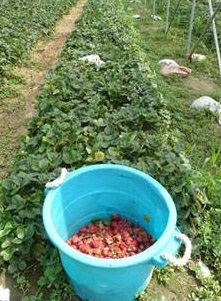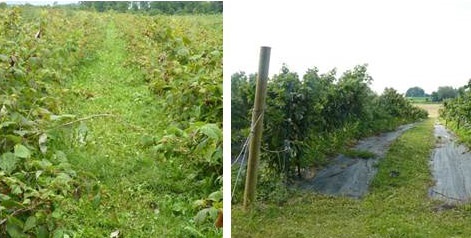Organic options for spotted wing drosophila management
Information on organic control strategies for spotted wing drosophila on fruit crops.
Spotted wing drosophila (SWD) is an invasive, direct pest of berry crops and other soft skinned fruit. In just a few years this pest has permeated all of the major fruit growing regions in the USA, British Columbia, and Eastern Canada.
Spotted wing drosophila is a serious problem because it lays eggs in fruit as the fruit is ripening . SWD eggs, larvae, and pupae are present in the fruit at harvest. Fruit loses its integrity and breaks down early. The pest has multiple generations a year and populations build up very quickly. Late-season fruit , such as fall-bearing raspberries, blueberries and day-neutral strawberries, are almost sure to be infested with SWD unless growers actively manage this pest.
Control of SWD is a challenge for organic as well as conventional growers.
Organic insecticides
Insecticides are an important part of an SWD management program; weekly applications can provide SWD control while fruit is ripe and ripening.
We anticipate an emergency use registration for the insecticide ENTRUST SC on berry and stone fruit crops for SWD control in 2014. Entrust (spinosad) is very effective for SWD and is acceptable in most organic programs. However, there will be limitations on the number of applications per season, which means you might not have enough applications to protect crops with a long harvest period. Also, Entrust (insecticide group 5) should not be used repeatedly because resistance management is a concern. It is important to alternate insecticides from different groups. In California, SWD has already developed resistance to the organic insecticide Pyganic, when this insecticide was used repeatedly.
Watch for updates on emergency use registrations of organic products for SWD control at Ontario.ca/spottedwing. Insecticides alone will not provide adequate SWD control, and researchers are actively searching for more sustainable options. Many other management practices must be incorporated into an SWD program.
Harvest schedules
The most important management strategy for SWD is to harvest frequently and thoroughly. Ideally all ripe fruit should be harvested every day or two. On pick-your own farms, where harvest is seldom thorough, growers should send workers in after the customers, to clean up the field. By adjusting harvest schedules to accommodate thorough and frequent harvest, growers have found good SWD control in raspberries, and day neutral strawberries. However, this is not a very practical option for blueberries or blackberries which are picked once or twice a week.
Removing over-ripe or damaged fruit
Removing unmarketable fruit from the field can reduce the build-up of SWD, but the cost-benefits of this expensive management practice are not really clear. However, in organic settings, where insecticide options are limited, removing unmarketable fruit can pay off (Figure 1). This waste fruit should be buried daily at least 30 cm deep, or held in sealed containers for a few days. Don't leave it in exposed piles to compost.
Post- harvest cooling
Cooling to 1.6°C (35°F) degrees immediately after harvest will slow the development of SWD in harvested fruit. If fruit is held for three days at this temperature, many eggs and small larvae will die. However, once SWD has laid eggs in fruit, shelf life is compromised because the surface of the fruit has been damaged. Post-harvest cooling should be used together with immediate marketing of fruit.
Crop management
SWD populations are favoured by moderate temperatures and high humidity. Growers can influence SWD populations by making sure crops are pruned to facilitate airflow, reduced humidity around the crop canopy, and ease of harvest. Prune brambles and install trellis systems (Figure 2). Blueberries should be pruned to open up the canopy. June-bearing strawberries should be renovated as soon as possible after harvest. Runners should be clipped on day-neutral strawberries to reduce crop debris on the beds.
Ground cover management
Dropped fruit can be a source of SWD flies. Factors which favour desiccation of fruit, such as short grass, dry cultivated soil, or landscape fabric, could help to reduce SWD emergence from fallen fruit. Landscape fabric as a ground cover can also make it possible to rake dropped fruit up from the ground and dispose of it. Use of trickle irrigation, instead of overhead sprinklers, can help maintain a dry environment in the crop alleys and reduce humidity around the planting.
Management of wild hosts
SWD has many wild hosts (i.e. mulberries, honeysuckle, brambles, pokeweed, dogwood, buckthorn, pin cherry) that are common in Ontario landscapes. These wild hosts are important habitat for pollinators and other beneficial insects. It is not practical or desirable to remove all wild hosts around your farm fields. However wild blackberries and wild raspberries should be removed where possible, or mowed below the fruiting zone each spring.
Biological control
SWD has few natural enemies. Wasps parasitizing SWD have been identified in Ontario and elsewhere in North America, but biological controls are not providing economic control at this time. Most parasites of drosophila do not seem to be adapted to find this new invasive species, and parasitism rates are low, 1–2%. Research is underway in areas of Asia where the pest is well established to identify predators and/or parasites. Other researchers are studying the efficacy of biopesticides , with little success so far.
Exclusion
Exclusion of SWD from the crop canopy has been tried on a small scale for blueberries, and could also be used in high tunnels . The netting used to exclude SWD is commercially available, has a very fine mesh, and is heavier than bird netting. It must be installed over a structure that is sturdy enough to hold the extra weight. The bottom edge of the netting must be trenched in at ground level , or installed to prevent any gaps between the ground and the net. In addition, doors must be kept closed, something difficult to do when pickers are moving in and out. Negative side effects from reduced light and ventilation can be caused by the netting. Research is continuing on this option for SWD control.
For more information
For current and extensive information on Spotted wing drosophila, please see our website at Ontario.ca/spottedwing.
Growers can also listen to a recorded webinar by Dr. H. Burrak at North Carolina State University and Dr. V. Walton of Oregon State University, "Biologically Based Organic Management Strategies for Spotted Wing Drosophila". Some of the information in this presentation was used in the writing of this article.

